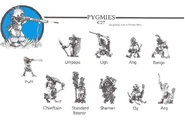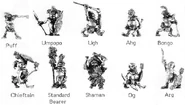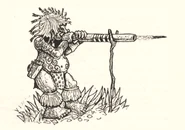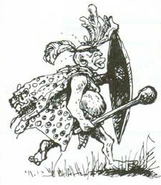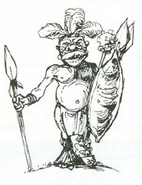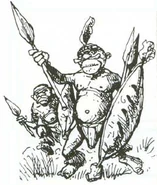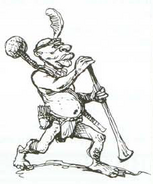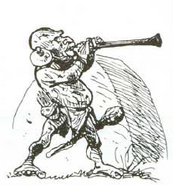"Pig-ah-meez [..] I remembers dem, all litt'l an' stingy they was. Nothin' on 'em. Not worth the cookin'. Waste o' bleedin' time."
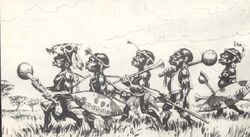
A group of Pygmies
Pygmies are the smallest of all the Human peoples of the Known World. Some Old Worlder scholars deny that they are Human at all, whilst others refer to them as "Lesser Men" or "Black Halflings."
Other scholars claim that they were a wholly separate creation of the Slann mage-priests of the Lizardmen.[10a]
Pygmies are native to the dense tropical jungles of the New World continent of Lustria where they live in small, tribal groups.
Anatomy and Physiology
Pygmies are short and squat, rarely more than five feet tall and often shorter. They are powerfully built and by no means puny. Their skin colour is dark and copperish, whilst their hair is always naturally black.[5]
"Giant Pygmies" supposedly exist in the fabled land of Lemuria, occasionally serving as mercenaries within the armies of the Ogre Kingdoms.[7a]
Culture
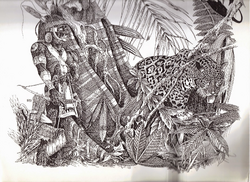
Unused Pygmy redesign for Warhammer Fantasy Roleplay 1st Edition
Pygmy culture is primitive, colourful and full of ritual. They often paint their bodies and are very keen on ornamental mutilation such as nose-bones, lip and ear plates, filed teeth, ritual scarring and tying great big weights to their tender bits. Filed teeth and ritual scarring are considered very attractive, at least by other Pygmies. Pygmies decorate their huts with the shrunken heads of enemies and captives are often "invited for dinner."
The Pygmies' chief skills are hunting and tracking rather than formal fighting, and their characteristic weapon is the blowpipe, with which they shoot poisoned darts. Pygmies survive largely by hunting crocodiles, monkeys and lizards, using poisoned darts to immobilise their prey. Their weapons and ornaments are made from bone, wood and stone, and the use of metals is altogether unknown, save from items traded with the Slann.
Pygmies speak their own strange tongue, although the occasional chieftain might know enough Norse or other Old Worlder tongues to get by at a trading post.[5]
Pygmies believe in two deities -- Brobat and Beesbok. Many deceased Pygmies join the Ancestor Spirits and their witch-doctors can summon them. Ancestor Spirits can be either benign or hostile.[4]
Pygmy Witch Doctors
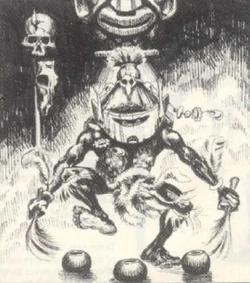
A Beesbok-aligned Pygmy witch doctor
Witch doctors are special tribal priests or shamans found amongst the Pygmies. They always follow one of the two major Pygmy deities, and have differing abilities according to which of their deities they support. They have some similarities to the alchemists of the Old World in their reliance on herbs and preparations, and lower magical ability than wizards of the same skill level.
When male twins are born in a Pygmy village a feast is held to celebrate the event and the two boys are ritually appointed witch doctors of the two gods, Brobat and Beesbok, with the fatter youth being assigned Beesbok. When they reach the age of fifteen they are given huts at opposite ends of the village; each then dedicates the remainder of his life to serving their god. If there is already a pair of witch doctors, the twins act as apprentices until the death of one of the witch doctors. When female twins are born a feast is also held to celebrate the event, and the two girls are ritually appointed as special "Guests of Honour." As such, female twins do not reach the age of fifteen.
Note that a village will either have no witch doctor, or two of them (one of each deity). However, each witch doctor pretends that the other does not exist. If asked, they will say that they are the only witch doctor in that village. They never speak to each other and avoid meeting at all times. When one of the twin witch doctors dies, whether from natural or unnatural causes, the other leaves the village to take up a wandering lifestyle. He may be persuaded to join parties or adventurers for short periods.
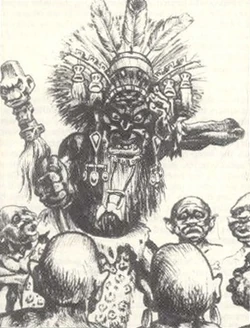
A Brobat-aligned witch doctor
Although Pygmy witch-doctors have some spells, they normally only use these in self-defence or while away from their home village, preferring to treat day-to-day problems with herbs, drugs and potions. Their actual approach varies according to which deity they follow: if a villager came to see them complaining of a rival in love, Beesbok's witch doctor might prescribe a love potion to be given to the object of affection, while Brobat's would probably offer a vial of poison to be given to the rival!
The witch doctor of Beesbok is most popular with the villagers -- they come to him because they assume that he will want to help. However, the witch doctor of Brobat is unpopular and generally shunned, but the villagers never openly oppose him and seek his advice because they are afraid of the retribution of Brobat. When a villager has a problem (illness, rival in love, flatulence, etc.) they will secretly consult both witch doctors and attempt to implement two sets of (usually extremely contradictory) advice.
Beesbok's symbol is a crude semicircle with its ends upwards (said to resemble a smiling mouth) while that of Brobat has the ends downwards. Many Pygmies carry this symbol on an item that can be quickly inverted, such as a shield, to that they can present the correct symbol if they should happen to meet either of the witch doctors.[4]
Forces of the Pygmies
Pygmy Heroes
- Standard Bearer - The contingent standard can be of many sorts, but it is always carried by a particularly brave warrior.
Pygmy Infantry
- Braves - Many pygmy braves use the blowpipe as their principle weapon, often with poisoned darts.
- Scouts - Adept trackers, blowpipers and hunters, skilled in the arts of tribal raising, head-taking, ambushing and skirmishing.
- Warriors - Young warriors who have proven their bravery by taking the heads of enemies in battle.
- Impis - Elite tribal elders, older and more experienced warriors who form the bodyguards of Chiefs.
Pygmy Lords
- Chieftain - Pygmy chieftains often grow enormously fat, as obesity is taken as a sign of rank amongst the tiny Pygmies.
- Witchdoctor - Pygmy shamans are tribal magicians whose powers are associated with nature and the environment.
Miniatures
Trivia
In the novel Sword of Caledor, in addition to vampire bats, sabretooth jaguars the size of horses, piranha lizards, disease, and a stegadon, Teclis and Tyrion's expedition fended off multiple Pygmy attacks in their pursuit of Zultec.[5a]
In the real world, "African Pygmies" is a name used by outsiders for several ethnic groups indigenous to the Congo Basin region of Central Africa, such as the Mbuti, Mbenga and Twa peoples. Most Pygmy people are very short in height (Pygmy men stand 149cm (4'11") tall on average) and usually have dark skin, brown eyes and black, curly hair. Historically, Pygmy peoples have been subjected to racism, discrimination, violence, cannibalism, slavery and genocide from some other African peoples in surrounding regions, as well as European (primarily Belgian) colonists.
The Pygmies were first released in 1984, during the 2nd Edition of Warhammer Fantasy Battle. They were introduced as servants of the Slann race, who predated the Lizardmen faction at the time. They were discontinued just four years later in 1988, followed by the Slann faction itself. However, they later returned as a background race, being mentioned in canon lore as recently as the 6th Edition.
An unpublished Lustria supplement for the 1st Edition of Warhammer Fantasy Roleplay sought to move away from the "dark-skinned Halfling" design, instead taking inspiration from real-world tribesmen living in the Amazon rainforest.[9]
A spiritual successor to the Pygmies -- the Jungle Halflings -- were planned to be reintroduced via the Warmaster game. They resembled Incas, and rode on Cold Ones. Pictures of them can be seen on the Collecting Citadel Miniatures Wiki.
Sources
- 1: Warhammer Armies (3rd Edition)
- 2: Warhammer Armies: Lizardmen (6th Edition)
- 3: Lustria (6th Edition Campaign)
- 4: White Dwarf 100 (September 1984)
- 5: Sword of Caledor (Novel) by William King
- 5a: Ch. 1
- 6: Warhammer Battle Bestiary (2nd Edition)
- 7: Warhammer Armies: Ogre Kingdoms (6th Edition)
- 7a: pg. 74
- 8: Gorfang And The Pygmies (Short Story)
- 9: Interview with Stephen Hardy
- 10: Warhammer Fantasy Battle Rulebook (3rd Edition)
- 10a: pg. 197
Gallery

